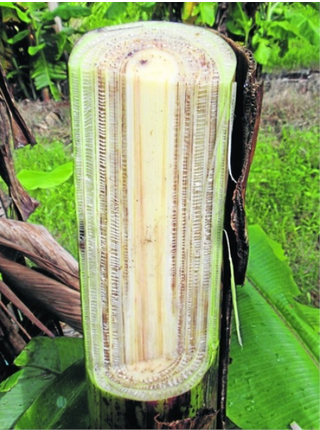| Banana |
Propagation
- Commercial bananas are seedless and propagated exclusively by vegetative means.
- The banana has a reduced underground stem, called the rhizome, which bears several buds.
- Each of these buds sprouts and forms its own pseudostem and a new bulbous rhizome.
- These daughter plants are called suckers.
- Banana is mostly propagated by rhizomes and suckers viz. sword suckers and water suckers.
- Sword suckers have a well developed base with narrow sword-shaped leaf blades at the early stages.
- Water sucker posses broad leaves, which do not produce healthy banana clumps. Suckers of 2-4 months age are selected.
- Other planting materials are whole or bits of rhizomes.
- Basrai variety in Jalgaon (Maharashtra) is as a rule propagated by dormant rhizomes.
- After cutting the parent plant, the rhizomes are removed from the soil, stored in cool, dry place for about 2 months.
- During the resting period the remaining part of pseudostem at the bottom falls of, leaving prominent heart bud.
- Conical rhizome should be selected while flat rhizomes to be rejected
|
|
| Tissue Culture |
Propagation
- Now-a-days banana plants are also propagated through tissue culture.
- Varieties like Shrimanti, Gross Michael and Grand Naine are commonly produced using tissue culture technique.
- Normally disease free plantlets with 3 - 4 leaves are generally supplied in pots for raising secondary nursery.
- Plants are initially kept in shade [50%] and as they harden, shade is reduced gradually.
- After 6 weeks, plants do not require any shade. Normally two months of secondary nursery is good enough before the plants to be planted in the field pits
|
|


